Saint
Petersburg
Written by Rick Archer
February 2012
|
Bitter
Disappointment
The founding of Saint Petersburg must be
considered one of Peter's greatest accomplishments. However,
Peter would first have to taste the bitter pill of an ignominious
defeat. Even worse, Peter's failed gamble would bring Russia to the very abyss of ruin.
Only a lucky break saved
Russia from destruction. As Peter wept with anguish, little
did he know there was a silver lining in the darkness. As fate
would have it, Peter's defeat contained the seeds that led to the creation of
Saint Petersburg. This is the story.
|
|
|
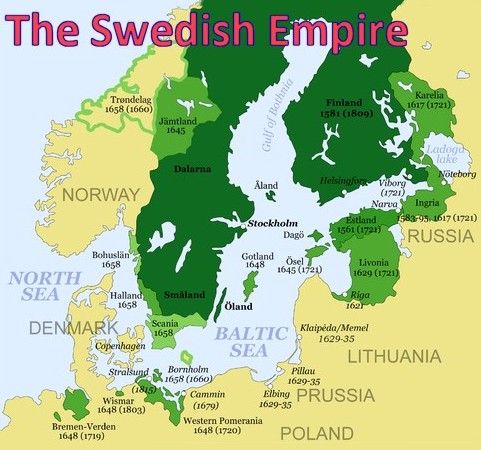 |
The Great
Northern War
On his return to Russia
from his European adventure, Peter found himself obsessed with the
dream of obtaining a maritime outlet. Peter's trip to England
had convinced him more than ever of the value of sea power.
Peter had learned first-hand how naval power had made England a
mighty nation. He was certain that what his country required to move
forward was an access route to the seas. Sea access would be
so valuable to Russia.
Peter preferred the
Black Sea. Unfortunately, he had
failed in one of his main objectives. During his trip to
Europe, Peter had found no allies against the Turks among the
Western powers. Realizing Russia couldn’t fight Turkey alone,
Peter begrudgingly gave up his dream of a Black Sea access.
Instead, he turned his
attention to the Baltic Sea. As you can see from the map, Russia was completely cut off from even a single port. Russia could not hope to
obtain her share of the trade and commerce of the world without a port.
Possession of an ice-free port was
critical to her economic development.
At this time, Russia’s
route to the Baltic coast was blocked by powerful Sweden.
Sweden had pried away much Russian territory in the past hundred
years due to
Russia's military weakness during the Time of Troubles.
|
Gustav Adophus was the
brilliant leader who started Sweden's surge. However, he had
died in 1632 at the end of the Thirty Years War. He was succeeded by
an equally adept leader in Charles X who continued his father's
expansion. Sweden reached its largest territorial extent in 1658
under the rule of Charles X. At the end of the 17th century
Sweden was the third largest country in Europe, surpassed only by
Russia and Spain. Sweden was the dominant power in the
region by a significant margin.
Russia may have been
huge in size and population, but that meant little. Its people were
servile, sullen and uneducated. There was almost no spirit of
nationalism. Furthermore, thanks to a century of weak
leadership, its military had little tradition. There was no
military academy and few qualified officers. Consequently the military was untrained and poorly organized.
Its commanders were all foreigners who weren't good enough to get a
job in their own country.
Peter knew all this.
Russia had a lot of catching up to do if it wanted to challenge
Swedish supremacy. Since Peter didn't think he
could conquer Sweden on his own, to dislodge
the Swedes, Peter allied himself to a three-way coalition: Russia,
Denmark and Saxony-Poland.
All three states
carried a grudge. They had each lost significant territory to the Swedes and their
brilliant leader Gustav Adophus throughout the 1600s.
Now they wanted it back and more.
Each country had
an agenda. Denmark's Charles V wanted to regain Scania
and other territories on the Swedish mainland lost in 1658.
Augustus II of Saxony-Poland wanted Livonia back (lost in
1629) to put an end once and for
all to Swedish economic predominance in the Baltic.
He
wanted to develop Poland's industrial base by using Poland's
raw materials and Saxony's economic know-how. However, he
could not do this while Sweden remained a commercial rival
in the Baltic.
Peter the Great simply wanted a foothold in the Baltic Sea. Russia could never be
great in the Baltic while Sweden was pre-eminent.
Sweden possessed three territories - Karelia, Ingria
and Estonia (see map) - that completely blocked
Russia's advance to the west.
The coalition
saw an opening when a fifteen year old king - Charles XII -
took the throne in 1697. They figured this kid would
be an soft target. They also had a shared belief that Sweden
was a spent force by the 1690s. This was the time when
Sweden's territory was vulnerable to be cut up by a superior
force.
Now was the time to attack.
|
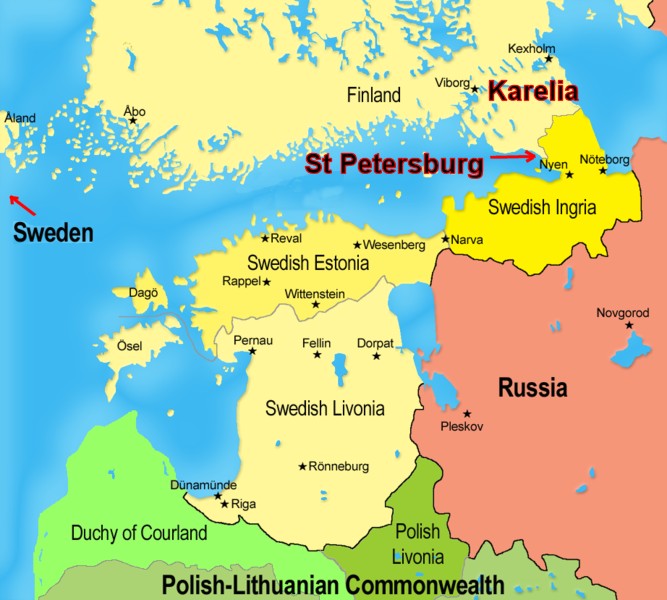 |
The
Battle of Narva
The story of the
Great Northern War can be summed up from the Russian point
of view as the Tale of Two Battles.
The war started
badly for the Alliance. The Denmark and Poland-Saxony opened hostilities in
April 1700, striking at Sweden from several directions at
once.
Moving to meet
the threats, 18-year old King Charles XII of Sweden elected
to deal with Denmark first. Leading a well-equipped and
highly trained army, Charles launched a bold invasion of
Zealand, the Danish island where Copenhagen is situated.
The Danes folded
fast. This campaign forced the Danes out of the war
right at the start. That left the Swedes with Poland
to deal with.
Russia was not in the war right at the start.
Peter did
not dare make war on Sweden until
his peace with the Turks was secure.
The Russian army was far too weak to fight two fronts at
once. While Sweden took on Denmark and Poland, Peter
swore to the Swedes that Russia had no intention of joining
the fight.
That was a
complete lie.
|
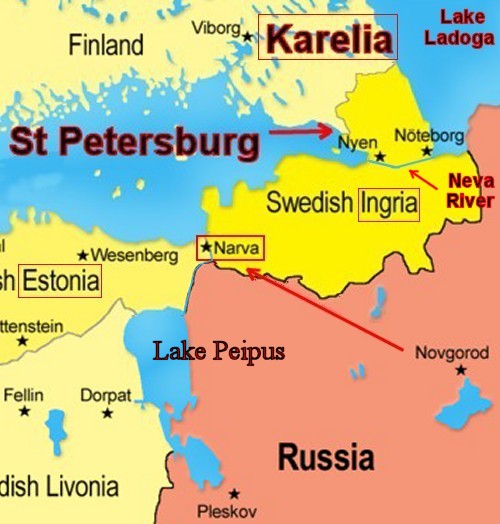 |
Peter had
targeted the city of Narva (see map) as his main objective. Narva
would give him the port on the Baltic that he so craved.
Narva had once been under Russian control from 1558 to 1581,
but Sweden had ripped it away when Russia entered its "Time
of Troubles". Peter wanted it back.
Narva was the nearest Baltic port to Russian
territory which made it supremely valuable to Peter.
Narva rested at the junction of the Gulf of Finland and the
Narva River which drained massive Lake Peipus
(see map), Europe's fifth largest lake. Access to
Narva would allow Russia to ship goods to the Baltic from as
far away as 200 miles using the Velikaya River.
Peter was quite
familiar with this area. Lake Peipus was where he had
learned to sail as a young boy, so he was well aware of
Narva's value. Peter figured that with Charles
distracted far away by Denmark and Poland, he could seize control
of Narva before Charles could possibly react.
Peter delayed
his attack till the dead of winter. By attacking in
November, he figured the weather would work to his
advantage. His forces only had to travel 50
miles while the Swedes would have to travel a considerable
distance to defend this valuable possession.
There was no
conceivable way the Swedes would ever be able to react fast
enough. Narva was easy
pickings.
Arriving at Narva in early November, Russian forces began
laying siege to the Swedish garrison defended by 2,500 men.
The Swedes were badly outnumbered. With
35,000 men, the Russian force was much larger.
|
Peter was supremely
confident. How hard could
this be? By the time the
Swedes came to the defense of Narva, Peter would already have his port.
Peter's timing wasn't as
good as he thought it was. After concluding business with
Denmark, Charles embarked across the Baltic with 8,000 men for Livonia in October with
the intention of driving the invading Polish-Saxon army from the
province. Landing in Livonia
(modern day Latvia), Charles noticed that the
Polish-Saxon army was now encamped for the winter.
Seeing that the Poles
were in hibernation, Charles decided instead to move east to aid the
city of Narva which had just come under siege by Tsar Peter's Russian army
three weeks earlier.
Narva was only 150 miles away.
Charles was there in a matter of days. The Swedes arrived
outside the city on November 29. It was a fortuitous break for
Sweden which caught the Russians completely caught
off guard.
Even though the Russians
still out-numbered the Swedish army by 3 to 1 (35,000 to 10,500), the Swedes were a fighting machine taking on an
inexperienced army with mediocre equipment. The Russian army
had not yet been fully modernized by the tsar.
What was supposed to be
an easy cherry picking romp had turned into a deadly threat. Peter's
luck could not have been worse... but then it did get worse!
Upon the surprise landing of the Swedes,
Peter decided he needed to head to Russia immediately and bring back reinforcements to meet the
increased Swedish threat.
Peter gambled that he had a couple days
to round up more troops. He never expected Charles would instantly go on attack.
But that was exactly what Charles did.
Charles attacked one day after landing.
On the morning of November 30, a blizzard
descended. Despite the foul weather, the
Swedes still prepared for battle. Meanwhile Croy,
Peter's stand-in, invited the majority of his senior officers
to a warm sit-down dinner.
Around midday, the wind shifted to the south, blowing the snow
directly into the Russians' eyes. Spotting
the advantage, Charles began advancing against the Russian center.
Using the
blinding snow as cover, the Swedes
were able to approach to within 50 yards of the Russian lines
without being spotted.
Surging forward, the
Swedes quickly forced the surrender of the
Russian center and captured Croy, the Russian commander.
|
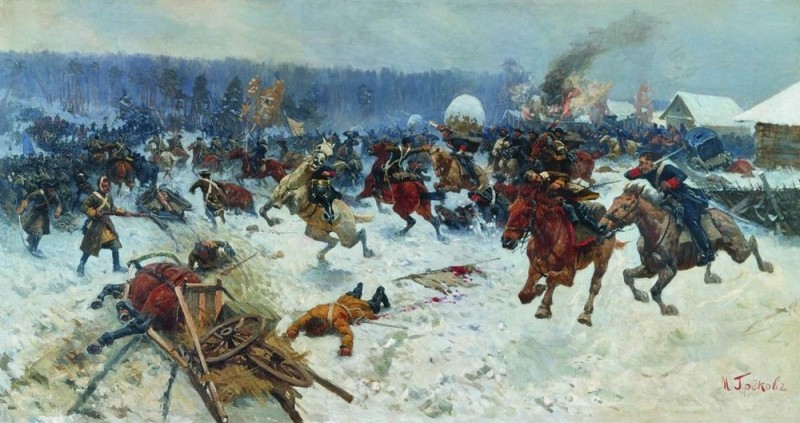 |
The remaining Russians tried to retreat and
regroup, but the weight of the panicking Russian forces led
to the collapse of a temporary pontoon bridge over the Narva River.
Their
escape route was destroyed. In an instant, the bulk of the army
was trapped. It was either jump into the
frozen waters of the river or fight to the death. White-faced,
the Russians turned back to look at the oncoming Swedes.
Seeing what happened and
seeing the look on the doomed men's faces, the Swedes stopped in
their tracks. The situation was so hopeless that the Swedish
actually started laughing at the helpless Russians.
One of the Swedes made a
suggestion. Did the Russians wish to surrender or did they
prefer to die? Humiliated, the Russians surrendered on the
spot.
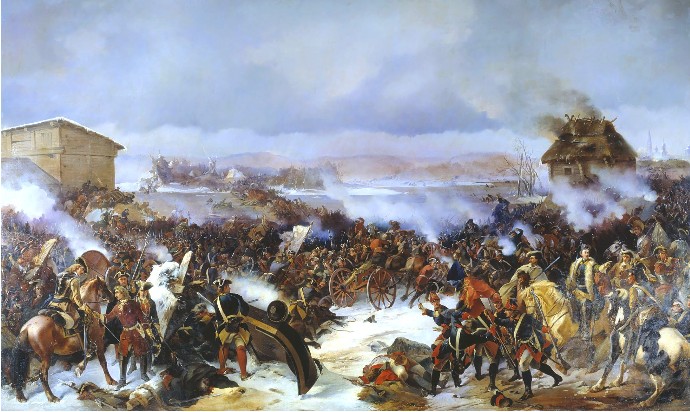 |
It was over.
20,000 men
had just been captured! Only 5,000 men were able to escape
back to Russia.
The
Battle of Narva was a stunning
victory for the Swedes against overwhelming odds.
Furthermore, this wasn't any ordinary defeat. It was a
thrashing of historic dimensions.
Indeed, the defeat was
so thorough it should have ended Russia's involvement in the
Alliance uprising once and for all.
In the fighting, Sweden lost 600
killed and 1,200 wounded. Russian losses were approximately
10,000 killed and 20,000 captured.
Just think about it for
a moment. How can any commander allow 20,000 men to be
captured? The level of incompetence involved was more than the
imagination can even grasp.
|
|
This famous
picture of the battle shows the Swedish Army disarming
the 20,000
Russians.
In addition to the
captured muskets,
the Swedes captured all of Croy's
artillery, supplies, and equipment.
The Russian army
was so severely decimated that Sweden now had an open field to
invade Russia.
Charles could march into Russia to destroy what was left of
the defenseless, disorganized ragtag enemy.
However, Charles did not pursue the Russian army. Charles was so
disdainful of the pitiful fight put up by the incompetent Russians
that he decided to move first against Poland, the more dangerous
opponent.
Charles had missed his
chance. By ignoring Russia when he had a sure-fire kill shot,
Charles had just given Russia the break it needed to live for
another day. That which doesn't kill you makes you stronger.
Charles would
one day regret his decision. Had he chosen
differently, the Swedish Empire might stretch all the way through to
Siberia today.
Think about that
for a moment. There was no army capable of stopping
Charles all the way to the Pacific.
|
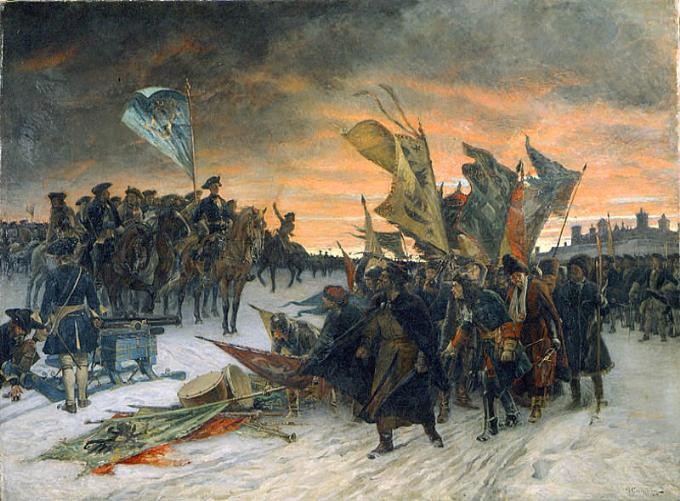 |
Out
of the Ashes
Peter was
devastated at the news. Imagine being informed that
you have just lost practically his entire army and all of
his equipment!
This wasn't just
Pearl Harbor. This was much much worse!
Furthermore, unlike Pearl Harbor, Peter was completely
responsible.
Peter went into
shock. How could this be possible?
In his wildest
imagination, Peter could not believe that his no-brainer attack on Narva
could have ended so disastrously. Peter had been so
confident that he and his staff didn't even consider the
most fundamental back-up contingencies and escape routes.
All in all, this defeat was a colossal, almost
incomprehensible disaster.
Peter's reckless
gamble had just left
his country's soft underbelly totally exposed to
counter-attack.
With the Swedes
literally at his doorstep, how could Peter possibly prevent Charles
from attacking Russian soil? Charles had most of his
men and all of his equipment! There was nothing between Narva and Moscow other than deep snow to stop Charles if he
so cared to press his advantage. If Charles moved as
fast on Russia as he had moved at Narva, he could be dining
at the Kremlin within a week.
Who knows why
Charles didn't move forward. One possibility was that
Charles did not realize the full extent of Russia's dilemma.
Did he not he realize there was no force left capable of
stopping the Swedes?
Perhaps the deep
snows concerned him. However the Swedish were no strangers to
snow. It hadn't stopped them at Narva.
Maybe
Charles worried there was no food to feed his
army in the cold of winter. However, it is unlikely that Peter
could have organized an effective food destruction effort
back in those days of slow communication. Charles
could easily have been deep into Russia territory before the
word even got out.
The likeliest
reason is that Charles assumed that Russia was decimated and
not worth the further effort. Like Denmark, Charles may have decided
that Russia had learned its lesson and would bother him no
further. Charles held the Russians in complete
contempt.
He thought the Russians were imbeciles.
They were nowhere near the threat posed by Augustus and his German army.
Charles definitely
did not want to leave a hostile German army at his rear
while pushing deep into Russia. Why not pursue Poland-Saxony,
by far the more
dangerous opponent, first?
Charles didn't
know Peter.
Peter seethed at
Russia's humiliation. Then it became personal. Peter discovered
that all of Europe was laughing at him too. His decision
to return to Russia on the eve of the attack looked to the
world like he had turned and run from a little boy at the first sign of
danger.
Peter bristled
at the world’s interpretation of his
departure from Narva the night before the battle. The victory for the Swedish Emperor brought him
enormous praise and the respect of Europe. On the
other side, the Battle of Narva made Peter look like a weak
monarch. Peter was labeled a coward and his army became a laughingstock.
Considering Peter's thin skin
and his need for European approval,
the world's contempt must have eaten at his soul.
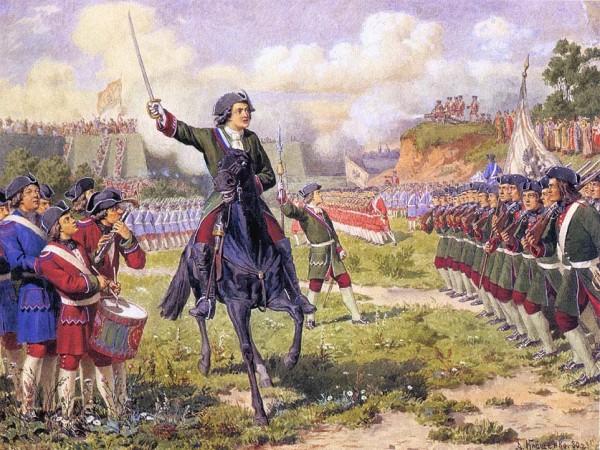 |
Humbled by his
defeat, Peter knew he was lucky beyond his wildest
imagination to be given a second chance. He now set
himself to the task of repairing his tattered army.
Peter decided he
had blundered badly, but it would be an even worse blunder
not to take advantage of the second chance offered to him by
Charles' error in judgment.
With his army's weaknesses exposed, Peter
knew exactly where to start. He saw that his army was
extremely unequipped and undertrained. He set out
right away to remedy this problem with the help of his boyar Shermetev, who oversaw much of the army’s modernization.
Russia adopted European battle tactics and bought updated artillery pieces.
Most important, they
established a military academy in St. Petersburg to teach
young men how to properly run the new army.
Over the next
few years, the Swedish army was never far away.
The enemy was a mere 400 miles away fighting
Augustus in southern Poland. With the constant threat
of Swedish invasion looming over them, the Russians had a powerful incentive to work hard.
The safety of Mother Russia depended on it.
|
|
Nöteborg
and Nyen - The Comeback Begins
|
After his
devastating victory at Narva in 1700, Charles of Sweden had
decided to pursue his Polish enemies deep into Poland.
While licking his wounds, Peter took note that the
fortresses at Nöteborg
and Nyen (see map) at either end of the Neva River were
vulnerable to attack.
When the cat's
away, the mice will play. It was impossible for Sweden
to protect every part of its vast territory. Sweden
simply didn't have the manpower to sufficiently guard far
flung outposts like Nyen and Nöteborg.
It is important
to note that Finland was part of Sweden back in 1700.
However, its people were not particularly loyal to Sweden
and certainly not interested in dying by rushing to defend
Swedish outposts under attack.
The Swedes had
two strategies to defend their distant outposts.
First, they made their forts strong enough to
withstand enemy attack until reinforcements could come (that
had worked like a charm in Narva). Second, if the
fortress fell, they would send an army, take it back and punish the
aggressors.
|
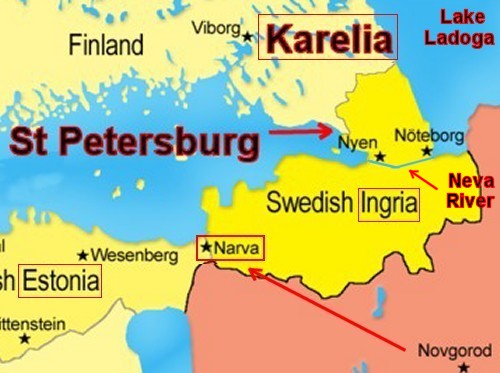 |
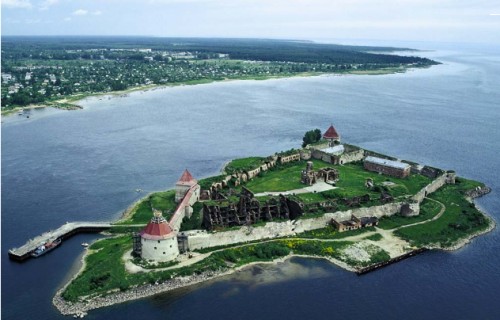 |
Nöteborg
As the pain of Narva
receded into the background, Peter was determined not to
quit. In September 1702, Peter
took a great risk by going back on the offensive. It had only
been two years since the defeat in Narva, but Peter was driven by
his lust for revenge. His new target was a fort situated on an
island blocking the junction of the Neva River and Lake Ladoga.
Peter assembled a force of 12,000 and marched for ten days to Lake
Ladoga. There he laid siege to Nöteborg. It was a
reckless move because it invited the return of the superior
Swedish army. If things went poorly for the Russians, Charles
might decide to inflict severe punishment on his foes.
Just like Narva, the
siege stalled. In an act of defiance
eerily similar to Greece's Thermopylae and the Alamo saga of Texas, the commander bravely refused to surrender
even though the fort was guarded by only 400 men.
|
Peter ordered the Russians to bombard the fort.
In this picture of the Siege, Peter is easily identified because he
is the tallest person standing.
After two weeks of heavy
bombing from the banks of the Neva, Peter decided he had waited long
enough. He had to take this place before the reinforcements
showed up. If these people weren't going to give in, it was time
to storm the fortress.
The Swedes put up a
ferocious defense against the assault. Despite receiving hits from an estimated
6,500 cannonballs, their fortress was still intact. Utilizing the fort
to full advantage, the Swedes repulsed one wave of attack after another.
The Russians were so
discouraged they wanted to quit. In desperation, their leader told
the boats to leave. Now the Russians would either have to
fight or die. This did the trick. The tide turned.
After a brutal 13 hour
fight, the Swedish commander finally agreed to stop. Of the
original 400, 250 were still alive. The Russians, meanwhile,
had lost 600 men in the fighting and 300 more were wounded.
Considering the odds, it
was not exactly an impressive victory, but Peter had his fort.
|
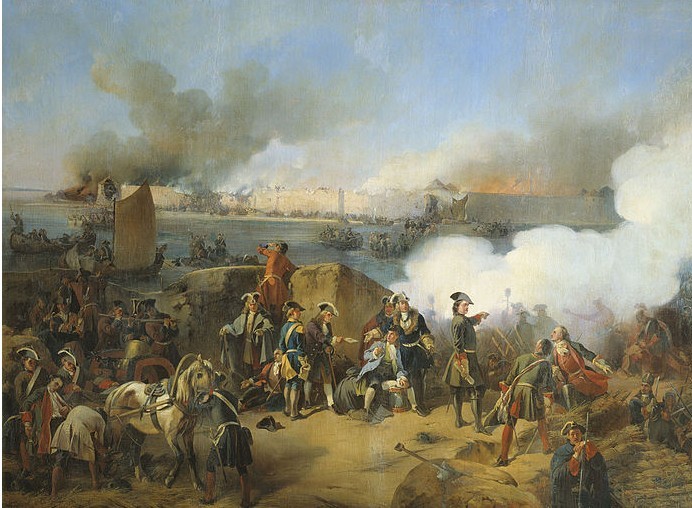 |
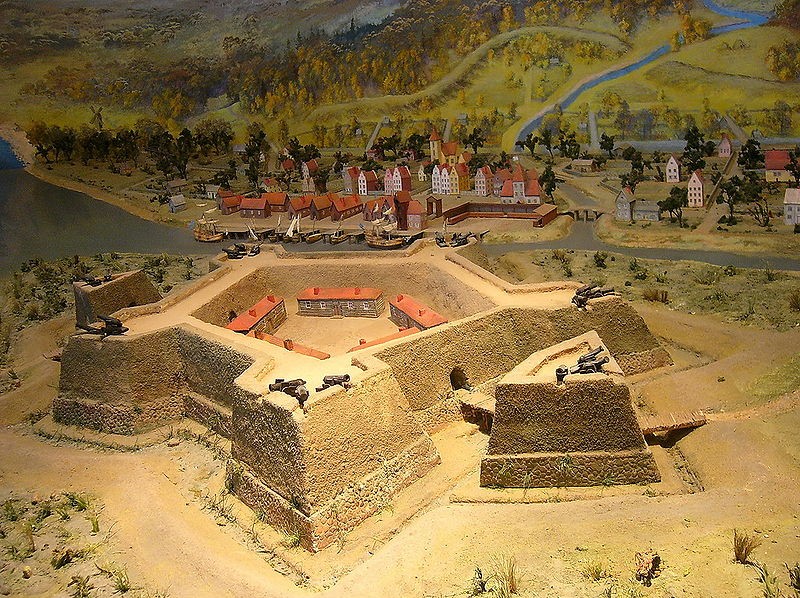 |
Nyen
Next up was the fortress
at Nyen which lay a mere 30 miles away at the other end of the Neva River.
The Nienchanz fortress guarded the mouth of the Neva where it connected
to the Gulf of Finland.
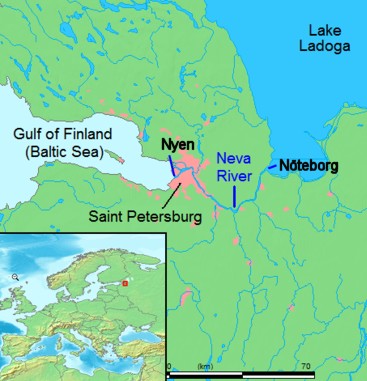 |
The
Founding of Saint Petersburg
|
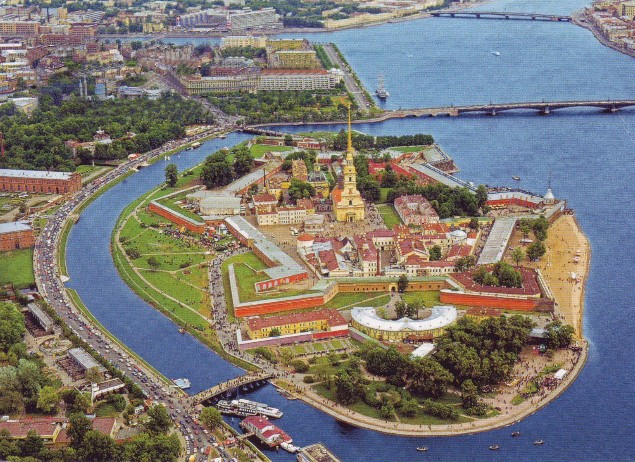 |
Unlike Nöteborg,
the Swedes didn't put up much of a struggle at Nienchanz.
After an 8-day siege, the Swedish garrison surrendered on
May 1, 1703.
At long last, Peter
had his cherished access to the sea. With Nyen under
control, Peter was determined not to lose this valuable
spot back to the Swedes.
To protect the newly conquered lands on the Neva delta,
Peter the Great needed a better fortress. The Nienchanz
fort was
no use. It was small
and badly damaged. Peter immediately began looking
for a different way to fortify the area.
Peter recalled how
difficult it had been to attack the island fortress of Nöteborg.
The water had acted like a giant moat. Peter chose Hare's Island
in the middle of the Neva to build the
Peter and Paul Fortress.
Peter pushed his
men to the limit. His greatest fear was that the
Swedes would return before he could adequately defend his
new prize.
On May 27, 1703,
the fortress was founded. No one knew it at the
time, but this day would come to be known as the
official birthday of Saint Petersburg.
|
During the frantic construction of his new fortress, Peter
became more and more intrigued with this area. He realized that existing ports like Narva
or Riga tended to be freer of ice in the winter. However to take
these cities by force would surely invite massive
retaliation by the Swedes. What if he built a seaport from the
ground up?
Peter looked around. This
desolate, barren area was scarcely populated. It consisted of little more than the ruined Nienchanz Fortress. There was a good reason why the area was
abandoned - these were vast swamplands known as the Neva Delta.
The Neva River drained a
vast Russian watershed into the Baltic Sea. During the rainy part of
every year, the whole region was flooded by water. There was
little solid ground available to build the fort, much less an actual
city.
|
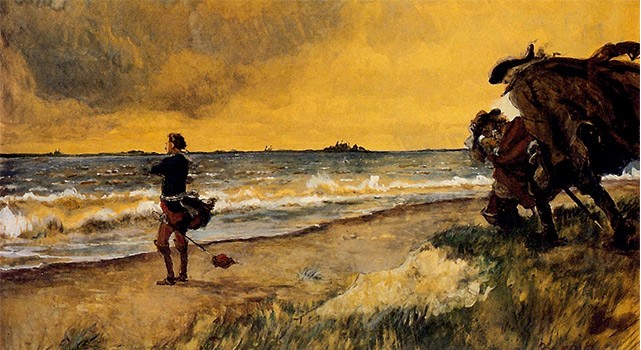 |
Surely no one
would be stupid enough to build a city here.
Or would they?
|
In real estate
terms, this place did have one good thing going for it.
Location Location Location.
Peter took one look at the
Neva River and realized how easily this giant waterway could
someday be used to transport goods in and out of Russia's interior.
Then he looked at the vast Gulf of Finland and saw what a
fine port this spot would make. Peter made up
his mind.
The Neva would
become the Volga of western Russia. This new city would
become Peter's Window looking out to Europe.
When he told his
engineers of his plan, they blanched in terror. They
quickly exclaimed that it was sheer folly to be building on
mud and quicksand. Just in the brief time they had
been working on the new fortress they had already
encountered the infamous Neva floods.
|
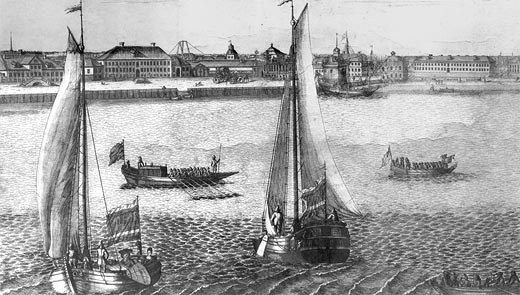 |
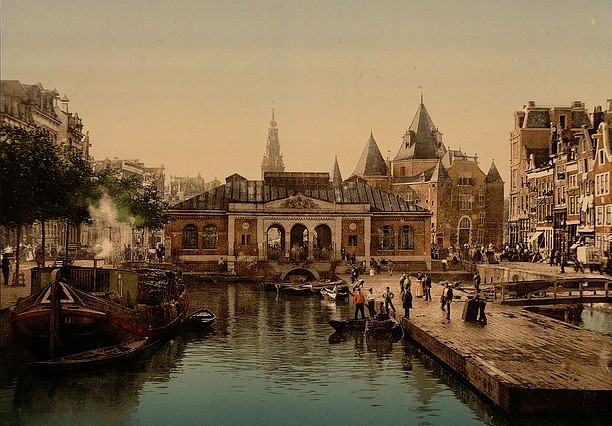 |
Peter was
undeterred. Peter ignored the
criticism because he already knew it was possible to build a
floating city.
During his
European Tour a few years earlier, by chance Peter had
fallen in love with Amsterdam. Like St. Petersburg,
Amsterdam was built in a river delta area.
The Dutch
had brilliant engineers who knew just how to reclaim land
from the sea. With
60 miles of canals, 90 islands, and 1,500 bridges, this
Dutch city had become famous throughout Europe for its exquisite canal system.
Thanks to his
unforgettable experience in Europe five years earlier, Peter had
seen just the
model he needed.
He began to fashion his city in the
image of Amsterdam.
|
It was insanity enough to build a major city upon what
amounted to a floating base. It was even more insane to build
a city in such an exposed, vulnerable place in the middle of a major
war.
One swift attack from
the Swedes, a couple of torches in the right place, and the new city
would go up in flames. Peter lost a lot of sleep worrying
about that exact scenario. After all, his new fortress was
makeshift at best. It probably wouldn't stand up under attack.
Nonetheless, Peter’s opportunistic nature got the best of him. War or no
war, he was too impatient to wait. So with the war in progress, Peter
began to map out his new town.
Peter began a race against
time. It is said he suffered constant nightmares from fear
that Charles would come and rip it all away from him. He constantly upgraded the
construction of his Peter and Paul Fortress. The original clay walls and bastions of the fortress were
completed by the end of summer 1703 under Peter's careful
supervision.
|
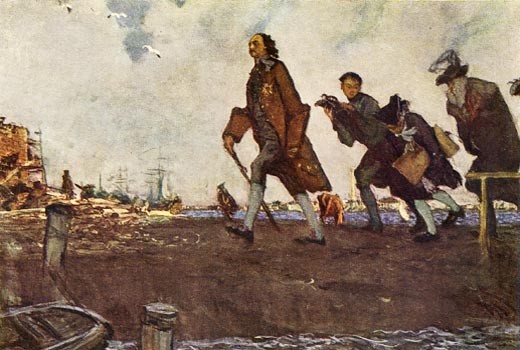 |
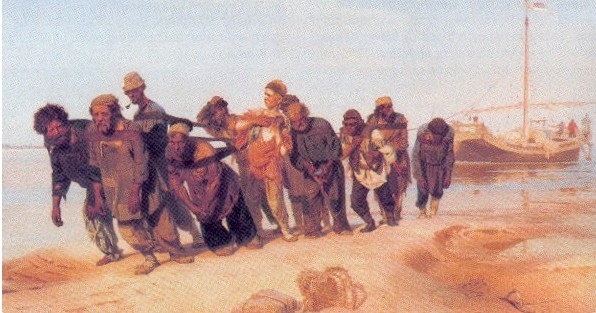 |
True to his decisive character, Peter ordered thousands of
peasants brought to the area.
He ordered them to cover the swamp with
tons of earth brought in on boats.
Russia was not a modern
country. However, one thing it did have was plenty of dirt and
countless slave-labor serfs to dig it up and drag it in.
Saint Petersburg was
being built by nameless, hopeless people who received practically nothing in
return for their sacrifice. They worked because they were
whipped if they didn't.
The
builders of the fortress were mostly soldiers and peasants
who
worked in very primitive conditions. The climate was
very cold and damp. Even when they weren't being
rained on, they worked in soggy, sloppy mud.
They would shiver for
practically the entire day.
|
Good housing was nonexistent and food
was in very short
supply. Furthermore the mosquito-infested swamps
guaranteed disease. Back in those days, the role of the
mosquito in spreading disease was not known. However, people
did know that wherever there were swamps, there was a
danger of disease.
Sure enough, working from dawn to dusk, the
men died in great
numbers. Some died from disease; still others died from
overwork. Since the work never stopped, some
people simply died right where they worked due to
hunger, exhaustion and cold.
These
people were treated little better than slaves.
Peter never hesitated
due to the death rate. This place had too much
strategic importance. With the war looming in the background,
the fort and other defenses had to be
completed as soon as possible. Peter continued constructing the city despite the losses and extra expenditures.
Peter's obsessive attempt to
build on the swampy
land would eventually work out after years of work.
However, when one takes note of the countless
deaths, that
explains why St. Petersburg is sometimes called
"The city
built on bones". There are
said to be curses about the city.
Due to Peter's legacy
of extreme cruelty, some believe there might be some sort of dark karma hovering over the city.
As for the intense
suffering and the massive loss of life, concern for the
welfare of others had never been one of Peter's strengths. It is
unlikely he even noticed.
|
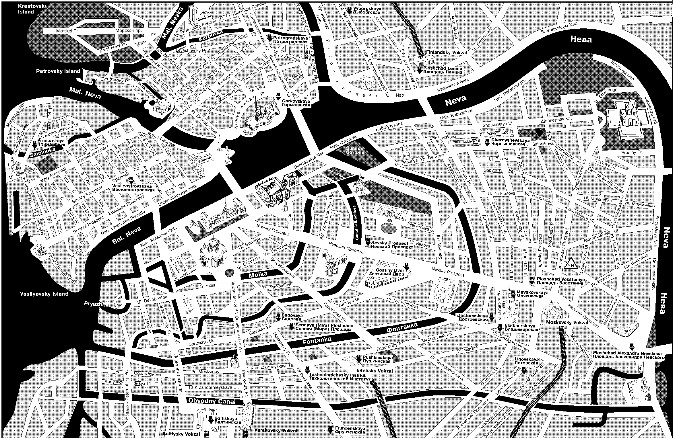 |
Meanwhile,
Peter's vision was taking place.
In a move eerily
similar to Dubai's creation of islands in the Persian Gulf
400 years later, Peter ordered vast amounts of earth brought
in to shore up all the little islands in the delta.
By filling in
gaps, many small islands were combined to make larger ones.
The main body of
the Neva was left alone, but the curves in the smaller
streams were straightened somewhat and given embankments.
As the islands were raised, these streams were turned into
narrow canals of standard width.
The design began
to take shape. Soon there were canals everywhere that
carved Saint Petersburg into several large islands and many
smaller ones.
This modern-day
map gives some idea of the scale of the accomplishment.
|
Danger
Charles XII, King of Sweden, was well aware of what was going on.
He knew about the fall of Nöteborg and Nyen. He knew
about the new city under construction as well.
He sent
several ships up the Gulf of Finland to check on the
progress. Each time the ships stayed just out of
cannon reach as they inspected the construction.
Just months after the groundbreaking came the attack Peter
was worried about. An army of 4,000
Swedes was spotted moving in from the north through Finland. Peter had done his homework.
He had a system of sentries posted to provide early warning.
At the first
opportunity, Peter had established a military academy at St.
Petersburg. In addition, he always kept a regiment of army soldiers encamped nearby.
Furthermore he had a National Guard of sorts consisting of
the men who supervised the serfs. Most
of the time these men were involved with building the city,
but they all knew how to use weapons. Peter made sure
his back-up army went through frequent
military drills "just in case".
The news of the advancing
Swedish force was straight out of Peter's nightmares.
On the spot, Peter assembled an army of
7,000 men to move against the Swedish menace. He led the
expedition himself. To his relief, his men checked the Swedish threat without much
trouble. Disappointed that their sneak attack had
no chance of success, the Swedes turned around at the first
opportunity.
Peter was still
worried. He
continued to
monitor enemy troop movements in
the area and naval activity in the Gulf of Finland.
Furthermore, while the city was under construction, Peter
was having new warships built on the other side of the river
|
Peter was done
attacking new territories. All he wanted out of this
war was a Baltic seaport.
Now that he had his prize, Peter intended to defend it
with every possible resource at his disposal. What he
lacked was a navy, so he went to work on building one right
on the spot.
Right across the
River Neva from the fortress, Peter constructed the fortified
Admiralty complex. This was a shipyard where
powerful ships of Russia's new Baltic Fleet were being built.
Many of these vessels would soon be involved in a series of naval
skirmishes with Sweden during the course of the Northern
War. From all accounts, Peter's new Russian Navy
acquitted itself well.
Charles
did
make one brief naval attack, but it too got nowhere. The
defenses were too strong. It soon
became apparent that Charles had waited too long. By
failing to attack during the infancy of the city, he had
given Peter enough time to make his pet project virtually
unassailable.
|
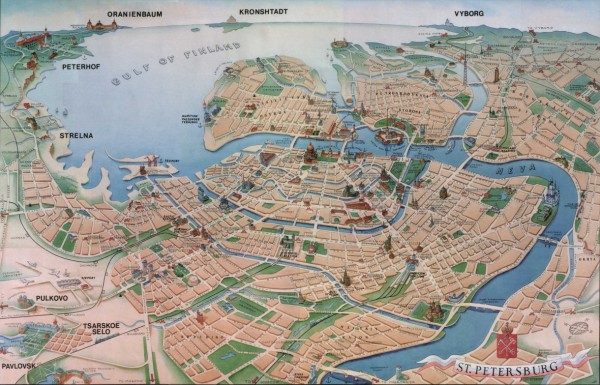 |
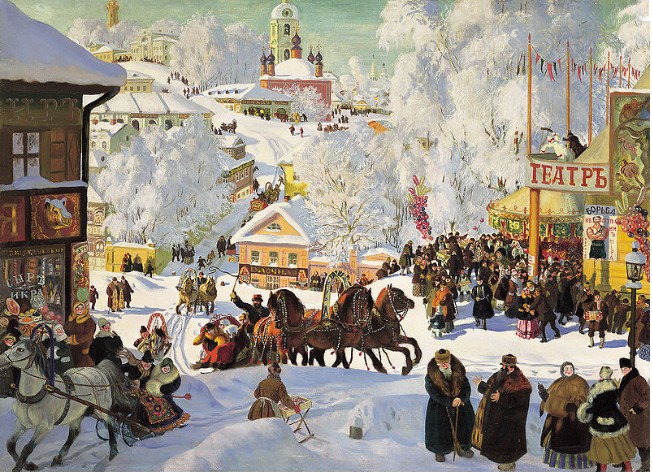 |
For its
first few years, the new city was
limited to a small town around the fortress. However,
the
work never stopped. Every year hundreds of tons of earth
were moved to
the location.
Slowly but surely the islands began to
rise safely well above sea
level. As the islands
were shaped and firmed up, more area became available for
new buildings.
Thanks to Peter's vision, this barren no
man's land went from a swampy, scarcely populated area to the
beginnings of a magnificent European-style city.
The finished product was
a thing of beauty.
By 1712, Saint Petersburg
was ready to become the magnificent new Russian capital.
|
After the city was completed,
in 1714 Peter ordered
the rich merchants and
intellectuals to move there from Moscow. Those who refused
risked getting out of favor with the emperor,
never a good idea (especially not with this emperor).
Most people
took the hint and followed
orders.
The nobles were
told to build on one side of the Neva River. Merchants
and artisans were told to build on the opposite side.
The new
residents of St. Petersburg were ordered to pay for the
building of avenues, parks, canals, embankments, bridges and
other projects. Huge government buildings, designed by
foreign architects, were constructed. Peter's grand
Winter Palace became the official residence of the monarchs.
Nobles were obliged to build homes in St. Petersburg and to
live in them most of the year. The more serfs
a noble owned, the bigger his home had to be.
Everyone was told to buy a boat. Overnight, the new
city turned into Europe's biggest yacht club.
|
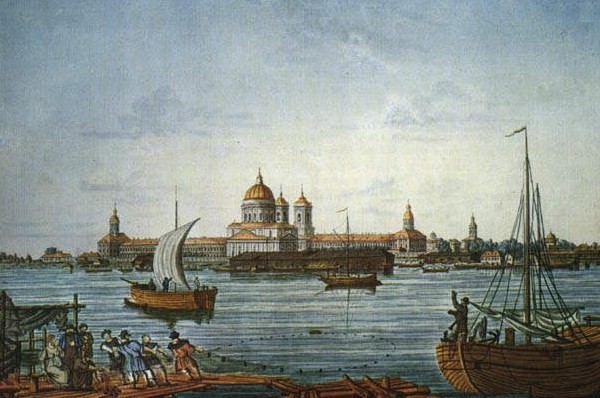 |
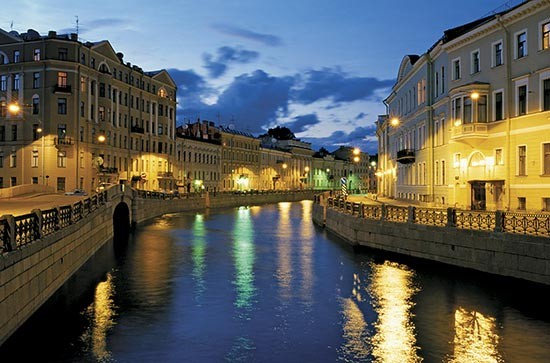 |
Everybody was amazed
that Peter's architects had somehow managed to tame the waterlogged
Neva Delta. Gone were the swamps.
Gone were the muddy little islands that rose mere inches above water
level. Gone was the dirty, reeking water. Gone were the
mosquitoes.
The islands were high
enough to provide solid embankments that kept
the Neva in check no matter what the season.
With the erosion of the
riverbanks checked, the muddy water was a thing of the past.
Now the water began to resemble the sparkling pure blue lake water flowing
down from nearby Lake Ladoga.
The Neva
quickly became the central focus of the city. Dozens of small
winding streams had been shaped into graceful smooth channels.
The waterways were simply exquisite.
Everyone agreed the
canals of Saint
Petersburg compared favorably to Amsterdam. The second "Venice
of the North" had emerged.
|
End Game
|
Following the
destruction of the Russian army
at Narva in 1700, Charles of Sweden
controversially had elected to turn south into Poland-Lithuania rather
than attack into Russia. The young king
thereby missed a key opportunity to take
Russia out of the war.
Charles wandered all
over Livonia chasing Augustus of Poland-Saxony. After two
years of pursuit, in 1702 Charles finally cornered
and defeated the Polish king Augustus and his Saxon allies at the
Battle of Kliszow in southern Poland.
After the battle, Augustus fled to
Germany. Now Charles was forced to track him down again.
Charles finally caught up to Augustus again at Leipzig and Dresden
in 1706, beating the Polish-Saxon leader handily both times.
At that point, Augustus
surrendered and made peace on terms acceptable to Charles.
Only one problem - Charles had spent six years chasing Augustus
around Eastern Europe. That had given Russia six valuable
years to prepare its military for Round Two.
Charles was still angry
over Peter's impudent seizure of Nyen and Nöteborg.
Now it was time to teach the Russians another lesson. After crossing
Poland, early in
1708 the Swedes defeated a Russian force at Grodno. Crossing
the Niemann River, the Swedish army was now on Russian soil.
Peter and the retreating
Russians set fire to what they could. As the Swedes advanced across
sparsely populated Lithuania they had difficulty finding food for
themselves and adequate forage for their horses.
|
Charles settled in Minsk
for several months of rest. In the summer of 1708, the
fighting resumed. Charles won a major battle at Holowczyn. Charles
reportedly said he enjoyed this victory even more than Narva. It was
time to head to Moscow.
The Russians were now in
full retreat. Worse, they were feeling quite demoralized.
Holowczyn had been a rout. It
seemed like their six years of military build-up had accomplished
very little.
Peter grimly stuck to
his scorched earth policy. Anyone who gave or sold food to the
enemy, or knew of such an act and said nothing, was to be hanged.
Those villages from which food was given to the enemy were to be burned
to the ground.
Peter's strategy began
to work. The Swedes reached Tatarsk only to discover the
countryside between them and Smolensk was barren of whatever they
needed to survive.
Charles had one card left to play. He was waiting for a supply
train of several thousand carts plus reinforcements coming from
Riga. However, by mid-September the supply train and the reinforcements
from Riga had still not yet arrived for Charles. His army was
in trouble.
|
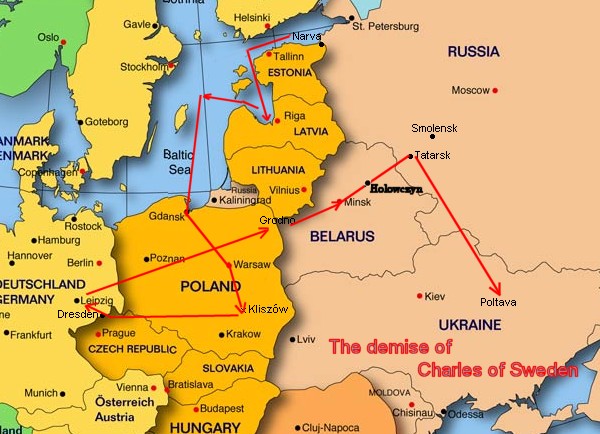 |
| |
|
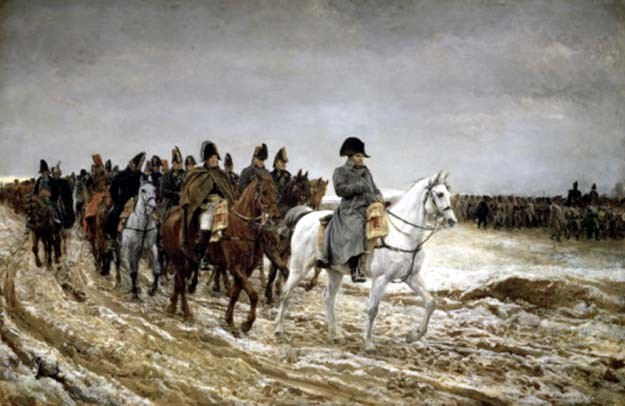 |
Starvation
Without the
supply train, Charles and his men and horses faced
starvation.
Charles was deeply
worried. It was absurd that he had never lost a battle to the
Russian army, but now the Russian countryside was about to
accomplish what the military could not do.
In a situation eerily
similar to Napoleon's fate waiting 100 years in the future, Peter
was winning the war simply by making the food disappear.
With the approach of
winter and nothing but devastation waiting ahead on the road to Moscow, Charles
had to abandon his Moscow strategy for the time being. Charles
decided to turn south. He headed into the Ukraine which was
more densely populated and likely held supplies of food and fodder.
|
Now Charles got more bad
news. His lifeline, the supply wagon train from Riga, had been
intercepted by the Russians. An eight hour battle had been
fought to a stand-off, but many Swedes had fled back to Riga at the
end of the day. With his passage blocked, the Swedish commander had no choice but to
burn the supplies lest they fall into Russian hands.
Charles briefly got lucky. As
he suspected, there was food to be found in the Ukraine.
Bunkering down near Kiev, his men discovered adequate supplies.
However the winter fighting took a toll on the Swedes. Charles
lost 1,000 men in January and more in another
skirmish in February.
Many of his troops
suffered from frostbite. The army was down to 24,000.
Local grain supplies and cattle were sufficient, but gunpowder was
low, some of it having been damaged by the wet weather in February.
Even more maddening were
the Cossacks who had taken to sniping from the forests as his men
passed by. This tactic was also used by the Russians during
Napoleon's retreat. This raises the question that perhaps the
Russians of 1812 got their inspiration from Peter's campaign.
|
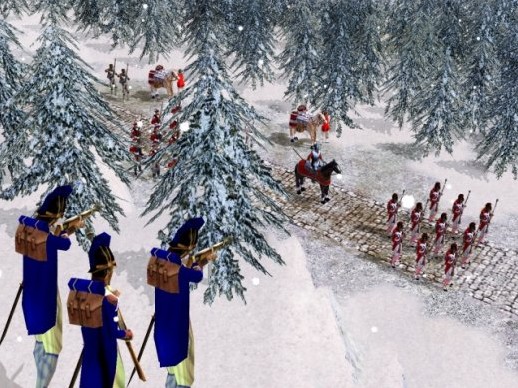 |
The loss of the supply
train was devastating. Charles was running out of time.
That's when an opportunity presented itself.
The Crimean Khan
situated just a couple hundred miles away contacted Charles about
joining the fight. The Khan had some scores to settle with Peter.
Why not set a trap?
Charles was running so
low on supplies that he accepted the risky gambit. He laid
siege to a castle in Poltava. It was his way of advertising "Here
I am. Come
and get me". The idea was to draw out the Russian army and
engage in a full-scale battle.
On the day of the
battle, the Khan would appear out of nowhere and spring the trap. One more victory like he
had at Narva might just be the knock-out punch he needed. Charles
knew a battle was nigh. His scouts told him that Peter
approached.
Just days before the
battle, Charles got the bad news. The Ottoman rulers that the
Khan served had ordered him to stand down.
Charles would have to
fight this one on his own. As chance would have it, Charles
was in great pain. He had recently taken a rifle shot to his
foot. With the effective scorched earth policy, the loss of
the supply train, the loss of this key ally and his own injury,
Charles surely must have thought his luck was running out.
Charles surely concluded he should have taken out Peter when he had
the chance.
|
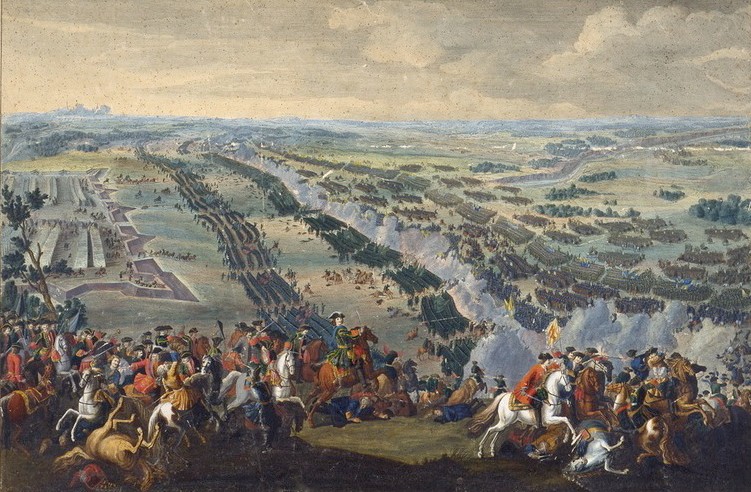 |
Poltava
In July 1709, Charles got the fight he
had asked for, but his gamble of calling out Peter failed miserably. Poltava is sometimes known as the
"Swedish Waterloo".
Charles quickly realized
it had been foolish to
advertise his position. The whole idea was to lay a trap. But
when his Crimean Tatar ally decided not to participate at the last
minute, Charles was the one who was trapped.
Charles was appalled to
discover he was confronted by a much larger and vastly improved
Russian army who were determined to defend their homeland.
The Swedes who stood
against the Russian army at Poltava in central Ukraine were
outnumbered and
outgunned. They had taken the field with excitement, but soon
realized this was a much different Russian army they were facing.
|
This time
the Russians were far better equipped than at Narva. The
Swedes were swiftly battered into submission by the powerful Russian
artillery. Peter had used his home field advantage to bring
every big gun he could find to use against the enemy.
Peter had also used the time to round up an enormous army.
Peter, acting as commander, used 53,000 troops to handily defeat the
Swedish army that had dwindled to 19,000 troops. Charles was
spirited off the field and took off fleeing for
Turkey in fear for his life. With bullets whizzing past him,
Charles just barely escaped across a
river by the skin of his
neck. Now the humiliation was his. The shoe was on the
other foot... probably the foot that wasn't shot.
The Battle of Poltava in 1709 represents one of the key victories in Russian
military history. Interestingly, the military plan of operations at
Poltava was of Peter’s own design. Peter had just gained his first
significant victory against a tested opponent.
Military historians view
the swift defeat as a major turning point in the fortunes of the two
countries involved. In analyzing the seeds of the Swedish
defeat, they concluded the Swedish troops
were overextended. Their years of chasing their opponents across Europe
had worn them down. Their food supply problems had weakened
them and their low supply of
gunpowder caused serious problems on the battlefield. But the
biggest mistake of all was simply staying in one place too long so
that Peter could take careful aim.
The
Dawn of the Russian Empire
|
There was a great irony
in Peter's victory at Poltava. In Round One, Charles had used
Peter's siege at Narva as an opportunity to pin him down.
How ironic was it that
in Round Two Charles had played right into Peter's hands with his
own siege strategy. Now that the tables were turned, the
Swedish had turned into sitting ducks against the vast Russian
artillery.
However, there was one
difference in the outcome. Peter showed absolutely no mercy.
No surprise there.
Peter reaped quick
rewards from Poltava. For the next several years, Peter took
advantage of several opportunities to snap up more Swedish
territory. With Charles stuck in Turkey along with the remnants of
the Swedish army, he was unable to come to the defense of Sweden's
Baltic properties. Peter was able to stage
successful assaults on Sweden's valuable eastern Baltic ports, including Viborg, Riga, and Tallinn (Reval) in 1710.
Peter even got Narva
back! Peter suddenly had more Baltic Sea ports than he
knew what to do with.
The newly-powerful
Russian army was able to advance on Livonia, Ingria and Karelia as
well. Sweden would never get these territories back.
From this point on, this once great nation would see its borders
shrink dramatically.
The Battle of Poltava in 1709 spelled the end of the Swedish Empire and
marked the
rise of the Russian Empire.
Oddly enough, Poltava
did not mark the end of the hostilities. Despite the Russian
success, Charles stubbornly continued the war against the advice of
his generals. Then one day in 1721 Charles got shot in the
head during a battle.
With its leader dead,
Sweden immediately sued for peace. In 1721 Sweden ceded the eastern shores of the Baltic to Russia (the striped areas
were given to Russia). The Great
Northern War had finally ended. Peter's victory in the Great
Northern War radically altered the balance of power in northern and
eastern Europe.
|
Winners and
Losers
|
The defeat of Sweden and the loss
of most of its overseas territories other than Finland and
Stralsund
rendered Sweden a minor power once again.
The events of the war
revealed for the first time decisively the political and military
weakness of Poland and Denmark.
Russia, by contrast, had defeated the former
great power of the region, recaptured a valuable slice of Finland
known as Karelia, acquired the Baltic provinces and part of Finland,
and founded St. Petersburg as a new city and new capital. Without
question, Russia benefitted greatly from this war.
|
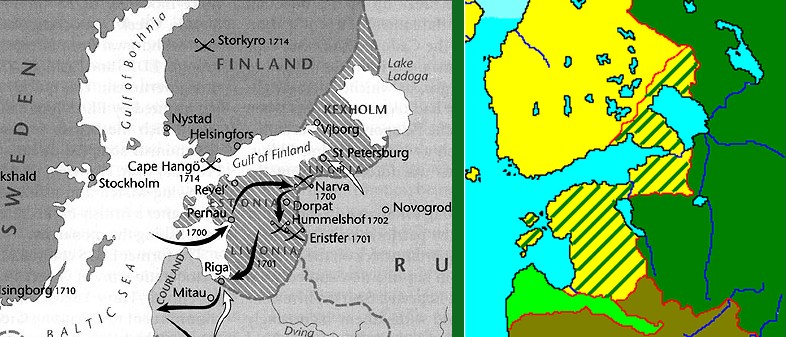 |
These acquisitions gave Russia a series of seaports to support both
trade and a naval presence in the Baltic Sea, as well as a shorter
route to Western Europe. Russia had finally gained its long coveted
window to the west.
Victory in the war
justified Peter's aggressive program of military, administrative, and economic reforms and
the Westernization of Russian culture. It also enormously reinforced
his personal prestige and power.
In November 1721, to
celebrate the long-coveted conquest, Peter officially assumed the
title of Emperor of Russia. Peter simultaneously declared Russia
had now become the Russian Empire. This proud moment was quite
different from Peter's dark nights of the soul after Narva 20 years
earlier.
Peter would live only
four more years, but on his deathbed he surely considered himself
fortunate to have lived long enough to see that his life projects
had brought Russia so much success.
As for Sweden, the
Finnish War of 1809 between Sweden and Russia saw control of Finland
go to the Russians. This was the final nail in the coffin of
the Swedish Empire. Sweden's days as Europe's third largest
country were long gone.
And all because a
teenager blinked when given the opportunity of a lifetime.
|
|